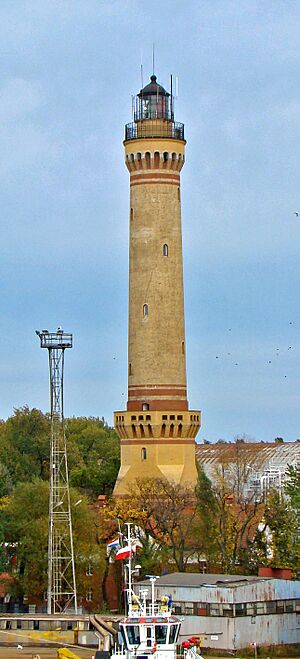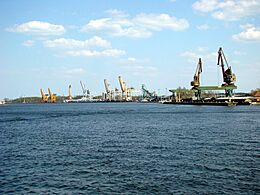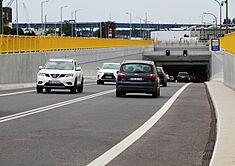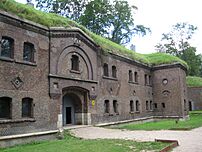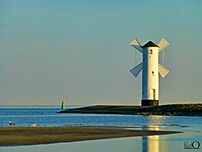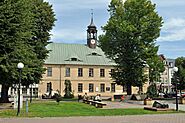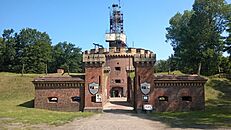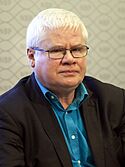Świnoujście facts for kids
Quick facts for kids
Świnoujście
|
|||
|---|---|---|---|
|
|||
|
|||
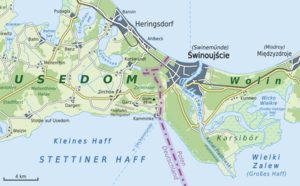 |
|||
| Country | |||
| Voivodeship | |||
| County | City County | ||
| Established | 12th century | ||
| City rights | 1765 | ||
| Area | |||
| • Total | 197.23 km2 (76.15 sq mi) | ||
| Elevation | 5 m (16 ft) | ||
| Population
(2012)
|
|||
| • Total | 41,516 | ||
| • Density | 210.495/km2 (545.180/sq mi) | ||
| Time zone | UTC+1 (CET) | ||
| • Summer (DST) | UTC+2 (CEST) | ||
| Postal code |
72-600 to 72-612
|
||
| Area code(s) | +48 091 | ||
| Car plates | ZSW | ||
| Climate | Cfb | ||
Świnoujście is a city and important seaport in Poland. It is located in the very northwest of the country. The city sits on the Baltic Sea and the Szczecin Lagoon.
Świnoujście is mostly built on two main islands: Usedom and Wolin. It also includes smaller islands like Karsibór. A special waterway called the Piast Canal was dug to help ships reach the city of Szczecin.
The city is right next to the German town of Ahlbeck on Usedom island. They are connected by a road and a long beach path. Świnoujście is part of the West Pomeranian Voivodeship. In 2012, about 41,516 people lived there.
Świnoujście is a key part of the Szczecin metropolitan area. A large gas terminal, the Świnoujście LNG terminal, opened in 2015. In 2023, an underwater tunnel, the Świnoujście Tunnel, was opened. This tunnel connects the islands of Wolin and Usedom. Even though it has a smaller population, Świnoujście is Poland's ninth-largest city by land area.
Contents
History of Świnoujście
People have lived in the area of Świnoujście for about five thousand years. This has been shown by old tools and other items found there. In the 10th century, the area became part of the new Polish state under Mieszko I.
In the early 12th century, the island became part of the Duchy of Pomerania. This duchy was connected to the Kingdom of Poland. Later, local princes ruled the area. They built castles on both sides of the river, but these were destroyed by Danish attacks in 1170 and 1173.
In 1297, Duke Bogusław IV allowed merchants to use the Świna river without paying taxes. This helped trade grow. The village of Świna was first mentioned in 1418.
During the Thirty Years' War (1618–1648), the city became part of the Swedish Empire. Later, in 1720, the Kingdom of Prussia took control of the area from Sweden.
Świnoujście (then called Swinemünde) was founded in 1748. It was given city rights by King Frederick II of Prussia in 1765. It served as the main port for the city of Szczecin. The city had wide, unpaved streets and houses built in a Dutch style. Its main activities were fishing and shipping.
The mouth of the Świna river was important for the harbor. It was protected by two long breakwaters and strong forts. A tall lighthouse was built on Wolin island. In 1897, the Piast Canal was opened. This canal made it easier for ships to reach Szczecin directly. This meant Swinemünde became a little less important.
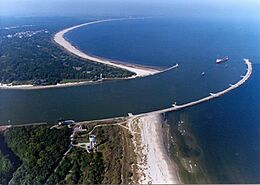
During World War II, the city was heavily damaged. In March 1945, the city was bombed by the USAAF. Many people were killed, and most are buried at the Golm War Cemetery. The port was also destroyed. On April 16, 1945, a British plane was shot down, and there is now a memorial for the pilots on Karsibór island. German ships were sunk in the harbor to prevent them from being captured. Soviet forces took control of the city in May 1945.
After the war, the Allied Nations decided on new borders for Poland. Świnoujście became part of Poland. The German people living there moved out, and Polish people moved in. The new border was confirmed by treaties in 1950 and 1990.
In 1948, the port of Świnoujście began to be rebuilt for trade and fishing. A large fish farm and factory were built. The port became a key center for fishing. Świnoujście was also one of the main ports where Greeks and Macedonians came to Poland as refugees of the Greek Civil War.
The spa part of the city was used by the Soviet Armed Forces until 1957. A Soviet naval base was also located there until the 1990s. In 1959, the "Uzdrowisko Świnoujście" State Enterprise was created. Today, it is one of the largest and most modern health resorts in Poland. It uses special bromide-iodide-sodium water found there.
In the 1960s and 1970s, a large seaport was developed. It worked together with the port in Szczecin. In 1964, ferry services to Scandinavia started again.
In 2015, the Świnoujście LNG terminal was opened. It is named after former Polish President Lech Kaczyński.
Geography
Świnoujście is located on the Świna Strait. This strait connects the Baltic Sea in the north with the Szczecin Lagoon in the south. The city is built on three islands where people live: Usedom, Wolin, and Karsibór. It also includes 41 smaller islands where no one lives.
The city's area is about 197.23 square kilometers. The city's beach grows every year because sea currents bring sand to the shore. Over the last 200 years, the shoreline has moved about 1.5 kilometers. The beach in Świnoujście is the widest in Poland, reaching up to 200 meters in some parts.
Climate
Świnoujście has an oceanic climate. This means it has mild winters and summers that are not too hot. The Baltic Sea has a big effect on the city's weather. In winter, Świnoujście is often one of the warmest cities in Poland.
| Climate data for Świnoujście (1991–2020 normals, extremes 1951–present) | |||||||||||||
|---|---|---|---|---|---|---|---|---|---|---|---|---|---|
| Month | Jan | Feb | Mar | Apr | May | Jun | Jul | Aug | Sep | Oct | Nov | Dec | Year |
| Record high °C (°F) | 15.0 (59.0) |
17.4 (63.3) |
24.2 (75.6) |
29.0 (84.2) |
32.7 (90.9) |
37.8 (100.0) |
36.1 (97.0) |
37.4 (99.3) |
30.4 (86.7) |
25.2 (77.4) |
18.8 (65.8) |
14.5 (58.1) |
37.8 (100.0) |
| Mean daily maximum °C (°F) | 2.9 (37.2) |
4.1 (39.4) |
7.3 (45.1) |
12.2 (54.0) |
16.6 (61.9) |
20.3 (68.5) |
22.6 (72.7) |
22.8 (73.0) |
18.6 (65.5) |
13.0 (55.4) |
7.3 (45.1) |
3.9 (39.0) |
12.6 (54.7) |
| Daily mean °C (°F) | 0.8 (33.4) |
1.4 (34.5) |
3.8 (38.8) |
7.9 (46.2) |
12.2 (54.0) |
15.9 (60.6) |
18.2 (64.8) |
18.2 (64.8) |
14.5 (58.1) |
9.7 (49.5) |
5.1 (41.2) |
1.9 (35.4) |
9.1 (48.4) |
| Mean daily minimum °C (°F) | −1.3 (29.7) |
−0.8 (30.6) |
0.9 (33.6) |
4.4 (39.9) |
8.4 (47.1) |
12.0 (53.6) |
14.4 (57.9) |
14.4 (57.9) |
11.2 (52.2) |
7.0 (44.6) |
3.0 (37.4) |
0.0 (32.0) |
6.1 (43.0) |
| Record low °C (°F) | −21.6 (−6.9) |
−23.6 (−10.5) |
−16.8 (1.8) |
−5.2 (22.6) |
−1.7 (28.9) |
2.8 (37.0) |
7.0 (44.6) |
6.4 (43.5) |
2.6 (36.7) |
−4.9 (23.2) |
−10.3 (13.5) |
−17.5 (0.5) |
−23.6 (−10.5) |
| Average precipitation mm (inches) | 43.5 (1.71) |
33.5 (1.32) |
38.6 (1.52) |
30.8 (1.21) |
51.8 (2.04) |
60.3 (2.37) |
72.9 (2.87) |
60.4 (2.38) |
54.9 (2.16) |
48.6 (1.91) |
45.2 (1.78) |
44.6 (1.76) |
585.1 (23.04) |
| Average extreme snow depth cm (inches) | 4.1 (1.6) |
5.3 (2.1) |
2.8 (1.1) |
0.4 (0.2) |
0.0 (0.0) |
0.0 (0.0) |
0.0 (0.0) |
0.0 (0.0) |
0.0 (0.0) |
0.1 (0.0) |
0.6 (0.2) |
3.1 (1.2) |
5.3 (2.1) |
| Average precipitation days (≥ 0.1 mm) | 16.13 | 15.31 | 14.13 | 11.07 | 12.40 | 12.93 | 14.10 | 13.03 | 13.03 | 14.83 | 15.47 | 17.37 | 169.81 |
| Average snowy days (≥ 0 cm) | 10.0 | 9.9 | 4.1 | 0.3 | 0.0 | 0.0 | 0.0 | 0.0 | 0.0 | 0.1 | 1.3 | 5.2 | 30.9 |
| Average relative humidity (%) | 88.2 | 85.3 | 81.5 | 78.0 | 78.2 | 77.3 | 78.7 | 78.6 | 81.7 | 85.4 | 89.6 | 89.7 | 82.7 |
| Source 1: Institute of Meteorology and Water Management | |||||||||||||
| Source 2: Meteomodel.pl (records, relative humidity 1991–2020) | |||||||||||||
Population History
| Historical population | ||||||||||||||||||||||||||||||||||||||||||||||||||||||||||||||||||||||||||||||||||
|---|---|---|---|---|---|---|---|---|---|---|---|---|---|---|---|---|---|---|---|---|---|---|---|---|---|---|---|---|---|---|---|---|---|---|---|---|---|---|---|---|---|---|---|---|---|---|---|---|---|---|---|---|---|---|---|---|---|---|---|---|---|---|---|---|---|---|---|---|---|---|---|---|---|---|---|---|---|---|---|---|---|---|
|
|
|||||||||||||||||||||||||||||||||||||||||||||||||||||||||||||||||||||||||||||||||
| Note: Międzyzdroje formed part of Świnoujście from 1972 to 1984 | ||||||||||||||||||||||||||||||||||||||||||||||||||||||||||||||||||||||||||||||||||
City Infrastructure
Transport
Świnoujście is located on both sides of the Świna Channel. For a long time, there was no road connecting the two parts of the city. People had to use ferries to cross. This ferry service was free.
In 2023, a new underwater tunnel opened. This Świnoujście Tunnel connects Poland's two largest islands, Wolin and Usedom. It cost 191 million Euros. This tunnel is the only direct link between the two parts of the city and the rest of Poland.
Świnoujście has the biggest and most modern ferry terminal in Poland. From here, you can take ferries to Denmark and Sweden. The city is also at the end of Polish National Route 3. This road is part of the European route E65, which goes across Europe.
The city has four railway stations on the eastern side of the Świna, on Wolin island. You can take regional trains to Szczecin. There are also long-distance trains to other Polish cities like Kraków and Warsaw.
Since December 21, 2007, you can drive freely between Świnoujście and Germany. This happened when Poland joined the Schengen Agreement. In 2008, a railway line was extended to Świnoujście Centrum. This gave the city a direct train link to the German railway network.
The closest airport is Heringsdorf Airport in Germany, about 13 kilometers west. It mainly has summer flights. For year-round flights, the nearest airport is Szczecin-Goleniów "Solidarność" Airport, about 80 kilometers away in Poland.
Tourist Attractions
- The old town hall is now the Museum of Deep Sea Fishing. It shows the history of sea fishing, sea animals, and old navigation tools.
- The Angel's Fort was built between 1845 and 1858. It looks like Hadrian's Mausoleum in Rome.
- The Western Fort was built between 1843 and 1863. It hosts concerts and art shows.
- The 18th-century Christ the King Church is in the city center. It has a wooden ship replica inside. Organ concerts are held there in summer.
- The Świnoujście Lighthouse, built in 1857, is 68 meters (223 feet) tall. It is the highest lighthouse in Poland and on the Baltic Sea. It is also the tallest brick lighthouse in the world.
- The Stawa Młyny is a special navigation light shaped like a windmill. It stands on a 19th-century breakwater.
- The Holy Mother "Stella Maris" church has beautiful stained glass windows. It was built in the late 1800s.
- The Eastern Fort, also called Gerhard's Fort, is one of three old forts from the 19th century. It has the Coastal Defense Museum. This museum shows the history of the city's forts.
- The Spa Park (Park Zdrojowy) is a historic public park in the western part of the city.
- The "well" is a tower from a Protestant church that was damaged in World War II.
- A shelter built in 1942 has an exhibit called "The town yesterday and now." It shows pictures and items from the city's history.
- The Karsibór district has an old Evangelical cemetery from the early 1800s.
- A Gothic church from the 15th century has an altar from the 15th century and a pulpit from the 17th century.
- A monument on Karsibór island honors Royal Air Force pilots. They were shot down by Germans during a raid in April 1945.
- Karsiborska Kępa is an island within the city limits. It is a bird sanctuary with about 140 different bird species.
International Connections
Twin Towns and Sister Cities
Świnoujście has friendly connections with other cities around the world. These are called twin towns or sister cities:
 Heringsdorf, Germany (since 2007)
Heringsdorf, Germany (since 2007) Nordenham, Germany (since 1992)
Nordenham, Germany (since 1992) Ostvorpommern, Germany (since 1998)
Ostvorpommern, Germany (since 1998) Ystad, Sweden (since 1990)
Ystad, Sweden (since 1990)
Former Twin Towns
Districts of Świnoujście
- Przytór
- Karsibór
- Wydrzany
- Łunowo
- Warszów
- Ognica
Sports in Świnoujście
- Flota Świnoujście – This is a football (soccer) club. They played in Poland's second-highest league from 2008 to 2015.
- Prawobrzeże Świnoujście – Another football club that plays in lower leagues.
- A free 5-kilometer (3-mile) Parkrun event takes place every week in Świnoujście.
Notable People from Świnoujście
- Theodor Fontane (1819–1898) – A German writer who lived here as a child.
- Elsa von Freytag-Loringhoven (1874–1927) – A German avant-garde artist and poet.
- Jerzy Hausner (born 1949) – A Polish politician and economist.
- Andrzej Smolik (born 1970) – A Polish musician and composer.
- Anna Harkowska (born 1980) – A Polish cyclist who won three silver medals at the 2012 Summer Paralympics.
- Michał Ruciak (born 1983) – A Polish volleyball player who was part of the national team.
Nearby Cities and Towns
- Szczecin (Poland)
- Międzyzdroje (Poland)
- Kamień Pomorski (Poland)
- Nowe Warpno (Poland)
- Ueckermünde (Germany)
- Ahlbeck (Germany)
Images for kids
See also
 In Spanish: Świnoujście para niños
In Spanish: Świnoujście para niños






